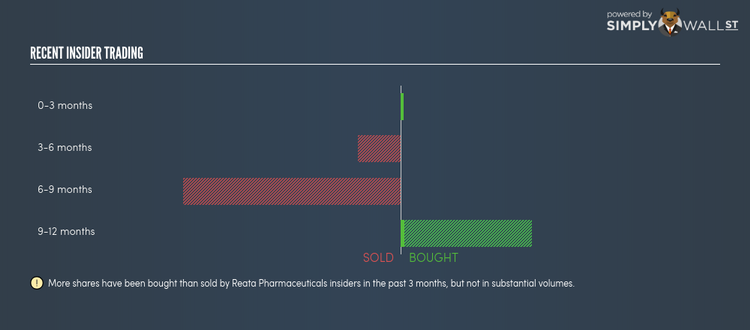Who Owns Most Of Reata Pharmaceuticals Inc (NASDAQ:RETA)?

In this article, I’m going to take a look at Reata Pharmaceuticals Inc’s (NASDAQ:RETA) latest ownership structure, a non-fundamental factor which is important, but remains a less discussed subject among investors. Ownership structure has been found to have an impact on shareholder returns in both short- and long-term. Since the effect of an active institutional investor with a similar ownership as a passive pension-fund can be vastly different on a company’s corporate governance and accountability of shareholders, investors should take a closer look at RETA’s shareholder registry. All data provided is as of the most recent financial year end.
View our latest analysis for Reata Pharmaceuticals
Institutional Ownership
RETA’s 48.08% institutional ownership seems enough to cause large share price movements in the case of significant share sell-off or acquisitions by institutions, particularly when there is a low level of public shares available on the market to trade. Although RETA has a high institutional ownership, such stock moves, in the short-term, are more commonly linked to a particular type of active institutional investors – hedge funds. For shareholders in RETA, sharp price movements may not be a major concern as active hedge funds hold a relatively small stake in the company. Although this doesn’t necessarily lead to high short-term volatility, we should dig deeper into RETA’s ownership structure to find how the remaining owner types can affect its investment profile.
Insider Ownership
I find insiders are another important group of stakeholders, who are directly involved in making key decisions related to the use of capital. In essence, insider ownership is more about the alignment of shareholders’ interests with the management. RETA insiders hold a significant stake of 19.68% in the company. This level of insider ownership has been found to have a negative impact on companies with consistently low PE ratios (underperformers), while it has been positive in the case of high PE ratio firms (outperformers). Another aspect of insider ownership is to learn about their recent transactions. Insiders buying company shares can be a positive indicator of future performance, but a selling decision can simply be driven by personal financial needs.
General Public Ownership
The general public holds a substantial 21.95% stake in RETA, making it a highly popular stock among retail investors. With this size of ownership, retail investors can collectively play a role in major company policies that affect shareholders returns, including executive remuneration and the appointment of directors. They can also exercise the power to decline an acquisition or merger that may not improve profitability.
Private Company Ownership
Another important group of owners for potential investors in RETA are private companies that hold a stake of 7.52% in RETA. These are companies that are mainly invested due to their strategic interests or are incentivized by reaping capital gains on investments their shareholdings. An ownership of this size indicates a strong financial backing and has the potential to influence RETA’s business strategy. Thus, investors should dig deeper into RETA’s business relations with these companies and how it can affect shareholder returns in the long-term.
What this means for you:
The company’s high institutional ownership makes margin of safety a very important consideration to existing investors since long bull and bear trends often emerge when these big-ticket investors see a change in long-term potential of the company. This will allow investors to reduce the impact of non-fundamental factors, such as volatile block trading impact on their portfolio value. However, ownership structure should not be the only determining factor when you’re building an investment thesis for RETA. Rather, you should be examining fundamental factors such as the intrinsic valuation, which is a key driver of Reata Pharmaceuticals’s share price. I urge you to complete your research by taking a look at the following:
NB: Figures in this article are calculated using data from the last twelve months, which refer to the 12-month period ending on the last date of the month the financial statement is dated. This may not be consistent with full year annual report figures.
To help readers see pass the short term volatility of the financial market, we aim to bring you a long-term focused research analysis purely driven by fundamental data. Note that our analysis does not factor in the latest price sensitive company announcements.
The author is an independent contributor and at the time of publication had no position in the stocks mentioned.


